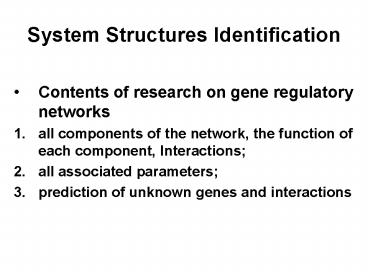System Structures Identification - PowerPoint PPT Presentation
1 / 23
Title:
System Structures Identification
Description:
bifurcation analysis Xenopus cell cycle analysis based on a set of equations describing the essential process of the Xenopus cell cycle ... – PowerPoint PPT presentation
Number of Views:39
Avg rating:3.0/5.0
Title: System Structures Identification
1
System Structures Identification
- Contents of research on gene regulatory networks
- all components of the network, the function of
each component, Interactions - all associated parameters
- prediction of unknown genes and interactions
2
System Structures Identification
- two major tasks ( because there are multiple
networks and parameter values that behave quite
similar to the target network. One must identify
the true network out of multiple candidates) - network structure identification
- parameter identification
3
System Structures Identification
- network structure identification
- two approaches
- bottom-up approach based on the compilation of
independent experimental data (through literature
searches and some specific experiments) KEGG
EcoCyc - top-down approach tries to make use of
high-throughput data infer network structures
from expression profiles and extensive gene
disruption data
4
(No Transcript)
5
System Structures Identification
- parameter identification ( the parameter set has
to be estimated based on experimental data) - parameter optimization methods
- brute force exhaustive search,
- genetic algorithms,
- simulated annealing, etc.
6
System Behavior or Function Analysis
- Contents of research on system behavior analysis
- functionalities of the circuits
- the robustness and stability of the system
7
System Behavior or Function Analysis
- functionalities of the circuits (a possible
evolutionary family of circuits as well as a
periodic table for functional regulatory
circuits) - Simulation
- Analysis Methods
- bifurcation analysis
- metabolic control analysis
- sensitivity analysis
8
Simulation tools
9
System Behavior or Function Analysis
- Analysis Methods
- bifurcation analysis Xenopus cell cycle analysis
based on a set of equations describing the
essential process of the Xenopus cell cycle - metabolic control analysis and sensitivity
analysis provides a useful method to understand
system-level behaviors of metabolic circuits
under various environments and internal
disruptions
10
System Behavior or Function Analysis
- the robustness and stability of the system
- adaptation, which denotes the ability to cope
with environmental changes - parameter insensitivity, which indicates a
systems relative insensitivity to specific
kinetic parameters - graceful degradation, which reflects the
characteristic slow degradation of a systems
functions after damage, rather than catastrophic
failure.
11
System Behavior or Function Analysis
- robustness is attained by
- System control such as negative-feedback and
feed-forward control - Redundancy whereby multiple components with
equivalent functions are introduced for backup - Structural stability where intrinsic mechanisms
are built to promote stability - Modularity where subsystems are physically or
functionally insulated so that failure in one
module does not spread to other parts and lead to
system-wide catastrophe
12
(No Transcript)
13
(No Transcript)
14
(No Transcript)
15
(No Transcript)
16
- Organized modularity model. Date-hub/module
network representation of the filtered yeast
interactome. Date hubs are represented as red
circles and modules are represented as blue
squares. The inset illustrates modular
organization in detail the date hub Cmd1
connects four modules at higher level, whereas
the nearby party hub Sec22 connects to eight
proteins within an endoplasmic reticulum module.
17
Test system for systems biology
- galactose utilization in yeast
how is the galactose utilization
system regulated and how is it interconnected to
other systems in the yeast cell?
18
(No Transcript)
19
(No Transcript)
20
Test system for systems biology
- Four distinct types of global datasets were
generated and analyzed - Genetic perturbations
- Testing network hypothesis
- Proteome analysis in wild-type yeast with the
system turned on and off - Kinetic analysis of global mRNA concentrations
change
21
Test system for systems biology
- Four distinct types of global datasets were
generated and analyzed - nine knockouts and the wild-type yeast were
interrogated when the system was running in the
presence of galactose and when the system was
shut down in the absence of galactose how the
expression patterns of all 6200 genes changed - most of these perturbations behaved in accordance
with the model, some discrepancies tested with
double knockout perturbations - 997 of 6200 genes had altered expression patterns
in these perturbations, they could be clustered
into 16 groups, Each group contained one or more
functional biomodules for the yeast cell (e.g.,
cell cycle, amino acid synthesis, synthesis of
other carbohydrates, etc).
22
Test system for systems biology
- Four distinct types of global datasets were
generated and analyzed - Testing network hypothesis the galactose
utilization module was interconnected to these
other modules and perturbations of it perturbed
the other modules - Cytoscape was developed to integrate global mRNA
concentrations, protein concentrations,
protein/protein and protein/DNA interactions. - The global datasets of the 997 perturbed mRNAs
were then joined to the global datasets of
protein/protein and protein/DNA interactions
23
- This network was developed by combining clusters
of messenger RNAs defined by the knockout
perturbation experiments and the protein/ protein
and protein/DNA interaction data. - The yellow arrows indicate protein/DNA
interactions (transcription factor activity) - the blue bars indicate protein/protein
interactions. - The red circle indicates the galactose-4 gene has
been knocked out. - A grayscale indicates levels of messenger RNA
expression - black equals high levels
- white equals low levels.































